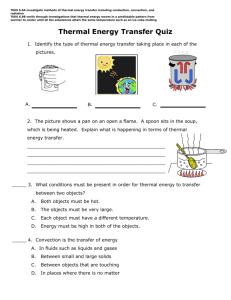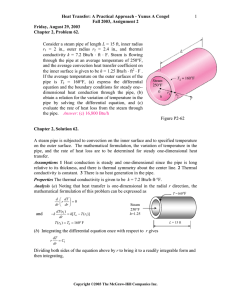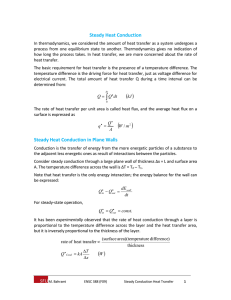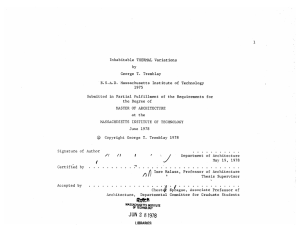Heat Diffusion Equation
advertisement
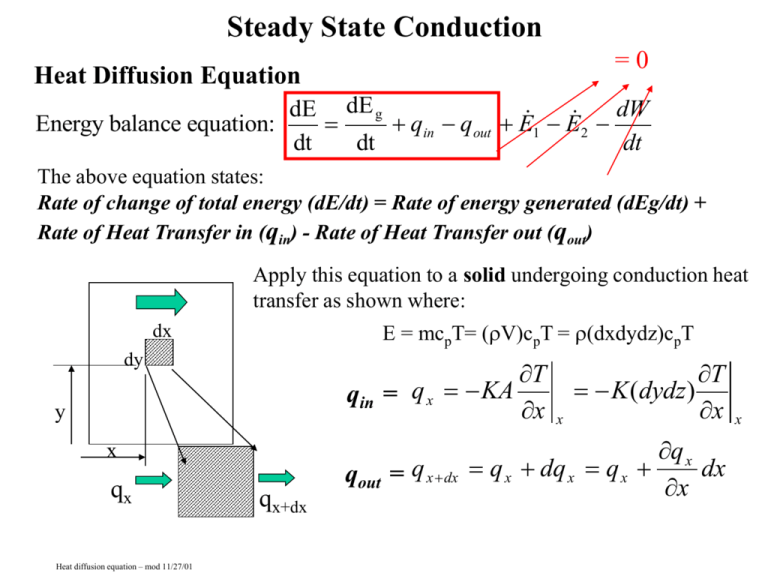
Steady State Conduction =0 Heat Diffusion Equation dE dE g dW Energy balance equation: qin qout E1 E 2 dt dt dt The above equation states: Rate of change of total energy (dE/dt) = Rate of energy generated (dEg/dt) + Rate of Heat Transfer in (qin) - Rate of Heat Transfer out (qout) Apply this equation to a solid undergoing conduction heat transfer as shown where: E = mcpT= (rV)cpT = r(dxdydz)cpT dx dy T qin = q x KA x y x qx Heat diffusion equation – mod 11/27/01 qx+dx qout = q x dx x T K ( dydz ) x q x q x dq x q x dx x x Heat Diffusion Equation (cont’d, page 2) Substituting in the Energy Balance equation, we obtain: dEg/dt EnergydE/dt Storage = Energy Generation + qin -qout Net Heat Transfer r c pT dxdydz qdxdydz qx qx dx t qx T rcp dxdydz qdxdydz qx (qx dx) t x T qdxdydz (k )dxdydz x x T T T T q (k ) (k ) (k ) => r c p t x x y y z z Note: partial differential operator is used since T = T(x,y,z,t) Generalized to three-dimensions Heat Diffusion Equation (cont’d, page 3) T T T T rc p q (k ) (k ) (k ) t x x y y z z Special case1: no generation q = 0 Special case 2: constant thermal conductivity k = constant T 2T 2T 2T rc p k ( 2 2 2 ) q k 2 T q, t x y z 2 2 2 where 2 2 2 2 is the Laplacian operator x y z Special case 3: 0 and q = 0 t 2 2 2 T T T 2 T 2 2 2 0, The famous Laplace' s equation x y z 1-D, Steady State Conduction Assume steady and no generation, 1 - D Laplace' s equation d 2T 0, T ( x, y, x, t ) T ( x ), function of x coordinate alone 2 dx Note: ordinary differential operator is used since T = T(x) only The general solution of this equation can be determined by integting twice: dT cons tan t C1 . Constant dx Integrate again T(x) = C 1 x C2 First integration leads to Second order differential equation: need two boundary conditions to determine the two constants C 1 and C 2 . Example: T(x=0)=100°C=C2 T(x=1 m)=20°C=C1+C2, C1=-80°C T(x)=100-80x (°C) T 100 20 x 1-D Heat, Steady State Heat Transfer Thermal Resistance (Electrical Circuit Analogy) Recall Fourier' s Law: dT q = -kA , If the temperature gradient is a constant dx Constant (heat transfer rate is a constant) q = constent T1 dT T2 T1 , where T ( x 0) T1 , T ( x L) T2 dx L T1 T2 T1 T2 dT T2 q kA kA dx L ( L / kA) x L T1 T2 L q , where R :thermal resistance R kA q (I) T1 (V1) This is analogous to an electrical circuit T2 (V2) R (R) I = (V1-V2)/R Thermal Resistance - Composite Wall Heat Transfer Use of the thermal resistance concept make the analysis of complex geometries relatively easy, as discussed in the example below. However, note that the thermal heat resistance concept can only be applied for steady state heat transfer with no heat generation. Example: Consider a composite wall made of two different materials R1=L1/(k1A) T T1 k1 k2 T1 T2 R2=L2/(k2A) T2 T1 T2 T1 T2T T1 T2 q R R1 R2 L1 L2 k A k A 1 2 L1 L2 L1 T1 T Also, q= , T T1 qR1 T1 q R1 k A 1 Composite Wall Heat Transfer (cont’d) •Now consider the case where we have 2 different fluids on either sides of the wall at temperatures, T,1 and T,2 , respectively. • There is heat transfer by convection from the first fluid (on left) to material 1 and from material 2 to the second fluid (on right). • Similar to conduction resistance, we can determine the convection resistance, where Rconv = 1/hA R1=L1/(k1A) Rconv,1= 1/(h1A) T T1 k1 k2 T2 T,1 where T,1 T1 Q T,2 L1 R2=L2/(k2A) L2 T T , 2 T, 2 Rtot T T2 R2 Rconv,2= 1/(h2A) T,2 T2 T , 2 T1 Rconv ,1 T1 T R1 T 2 T , 2 Rconv , 2 This approach can be extended to much more complex geometries (see YAC, 8-4 and 8-5) “R” value of insulations In the US, insulation materials are often specified in terms of their thermal resistance, denoted as R values, where Rvalue = L/k (thickness/thermal conductivity) In the US, it has units of (hr ft2 °F)/Btu (Note: 1 Btu=1055 J) R-11 for wall, R-19 to R-31 for ceiling. Q: Why is the Rvalue given by L/k ? A: From previous slide, we know that the thermal resistance to conduction is defined as the temperature difference across the insulation by the heat flux going through it, hence: T T x R T q" k k x Example: The typical space inside the residential frame wall is 3.5 in. Find the R-value if the wall cavity is filled with fiberglass batt. (k=0.046 W/m.K=0.027 Btu/h.ft.R) x 0.292 ft R 10.8( R. ft 2 . h / Btu) R 11 k 0.027 Btu / h. ft. R



